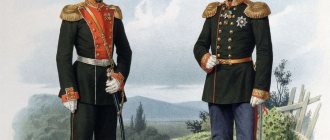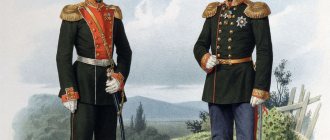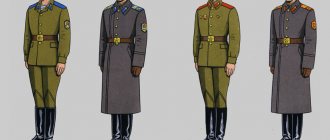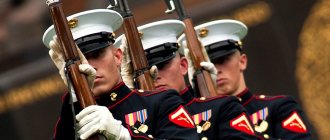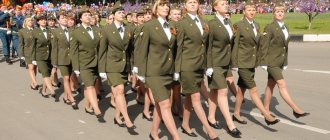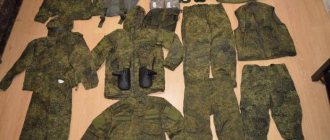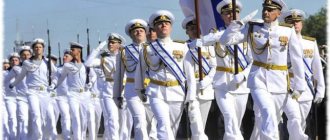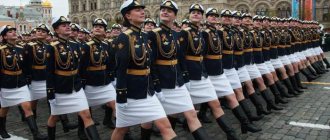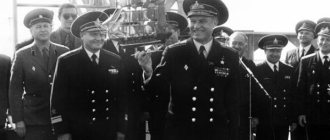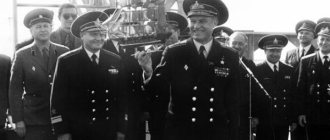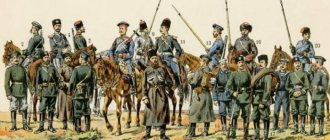History of the appearance of insignia
Starting from the 16th and 17th centuries, in the Streltsy troops, the commander differed from the ordinary in the cut of his uniform, a different type of weapon and a cane, by which one could understand the high status of the soldier.
In the regular army created under Peter the Great, non-commissioned officers were distinguished from the rest of the soldiers by gold braid, which was used to trim the brim of their hats. Officers' camisoles and caftans were also trimmed with this material. In addition, the officers had breastplates and other marks on their uniforms. In 1801, shoulder straps were introduced into military uniforms. They were marked with unit numbers and monograms of various types of troops. In addition to shoulder straps, army uniforms had epaulettes.
After the revolution, with the formation of the Red Army in 1918, a badge was issued to indicate membership in it. It was made of metal in the form of a wreath, consisting of two branches, laurel and oak. In the center of it was a red star, a symbol of the proletariat. In the central part of the star there was an image in the form of a plow and a hammer.
Overcoats and tunics wore buttonholes with an emblem corresponding to a specific branch of the military. In 1935, when personal insignia were introduced, an order was issued to place them in accordance with the rank of the serviceman. On the uniform of the commanding staff they were located in the form of emblems and on the sleeves. For Navy personnel they were located only in the area of the sleeves.
In 1943, by decree of the Commander-in-Chief, shoulder straps were returned to circulation, which were abolished after the revolution as a relic of tsarism, and in 1969, ceremonial shoulder straps made of silver and golden galloon were introduced for officers and senior command staff.
Features of the field uniform
The uniform of the RF Armed Forces has undergone a number of changes. The first thing that became noticeable was the different location of the shoulder straps. In 2010, a proposal was made to place them like NATO soldiers, namely in the abdominal area. True, many in the army reacted negatively to this idea. After all, soldiers are already accustomed to looking at the distinctive insignia located precisely on the shoulders.
Chevrons are placed on the sleeves. An innovation was the use by army men of fitted overcoats equipped with Velcro. In addition, for the first time in history, army uniforms began to include sweaters that provide maximum warmth. True, it was not possible to completely replace the boots and foot wraps.
Valentin Yudashkin was blamed for the failure of the new Russian suit. True, the designer spoke to representatives of the media and said that the clothes that were accepted for use largely did not correspond to the option he proposed. For example, in order to reduce the cost of the finished set, cheaper, low-quality materials were used. At the same time, they concluded that only the appearance was left from Yudashkin’s development.
When developing the new generation uniform, feedback from numerous army personnel in all regions of the country was taken into account. As a result, the new military uniform turned out to be multi-layered. Thanks to this, soldiers can independently select wardrobe items taking into account their goals and climatic conditions.
Clothes set number 1, like number 4, for the army includes several wardrobe items. In addition to the main suit, the new Russian army kit includes several different jackets and boots, which are designed to be worn at different times of the year. There is also a balaclava and a belt made of synthetic materials. Mixed fabric is used to sew wardrobe items. It consists of 65% cotton, and the remaining 35% are polymer fibers.
All representatives of the ground forces will have such army uniforms at the end of 2022. This is exactly what the Ministry of Defense planned. The equipment was replaced in several stages. The first hundred thousand sets were issued back in 2013. A year later, another four hundred thousand such sets were issued. In 2020, the army was given another five hundred thousand. Thus, more than a million soldiers were provided with new uniforms.
The army completely abandoned the use of foot wraps. Each soldier's military equipment includes twelve pairs of socks. They are intended to be used for one year. In the near future, their number is planned to double.
The Russian army currently has a couple of sets of equipment. The basic set in this case is intended for operation at air temperatures exceeding +15 degrees. In colder weather, a multi-layer option is used.
In winter, soldiers in the Russian army wear sets of underwear under their clothes. They are also available in two versions. There are fleece and lightweight underwear. The choice of one option or another in this case is made taking into account weather conditions. In the most severe frosts, you can wear both sets at the same time.
A set of summer equipment in the army consists of pants, a jacket, boots and a beret. Wardrobe items are coated with a special solution that has the ability to repel moisture. Thanks to this, the product does not get wet even under heavy rain for a couple of hours. In order to protect against negative mechanical effects, the army suit is equipped with reinforcing parts. Such kits are usually used in those parts where there is a high level of load.
The rules for wearing uniforms do not prohibit wearing a fleece jacket in the autumn. Thanks to the presence of pile, which covers both sides of the fabric, excellent thermal insulation is ensured. In windy weather, a private's outfit consists of a windbreaker and number five trousers.
In the fall, the Russian army uses a suit designed for the off-season. It is sewn from fabric that allows steam to pass through well, protects from strong winds, and dries quickly enough if it gets wet. If heavy rain begins, the use of a suit that protects not only from wind, but also moisture is allowed. In this case, modern membrane fabric is used to create it, providing the proper level of protection from adverse weather conditions.
In winter, soldiers wear an insulated vest and jacket. They protect the army man from wind and moisture, as well as cold weather. Despite this, wardrobe items have minimal weight and are practical. In particularly severe frosts, a balaclava and an insulated hat model are additionally used.
Wearing office uniform by military personnel
The rules for wearing dress, field and office uniforms are regulated by a special Appendix to the Order of the Ministry of Defense of the Russian Federation (except for the uniform of military personnel of the Navy). General provisions include:
- differentiation of uniforms by season and purpose;
- quarterly drill inspection of uniforms and equipment;
- compliance of the uniform with the type and type of troops;
- mandatory wearing of insignia for military ranks and departmental insignia on uniforms.
Office uniforms are not provided for field trips and exercises. An extract from the rules is as follows. Shirts and blouses with long sleeves are worn without a tie and without a jacket (with a button undone at the neck), with a tie and a jacket.
To wear a tie, there is a golden clip, which is attached between the 3rd and 4th buttons on the shirt. The zipper of the jacket collar opens 3-4 cm. Demi-season and winter outerwear is worn with all buttons fastened. The military muffler is neatly placed under the collar, with a protrusion of 1-2 cm.
Matching headgear and cockade
| Type of headdress | Cockade |
| winter hats (astrakhan and fur), caps, casual caps, wool caps, berets, | golden |
| winter insulated hats | khaki |
With a tilt to the right, only caps and berets are allowed to be worn. Other hats should be worn straight. Winter hats are worn at a distance of 2-4 cm from the eyebrows. Caps - with the visor located at eyebrow level.
New office uniform
The characteristic features of the office uniform deserve special attention. Essentially, this is a type of casual outfit. This equipment is used by officers and generals, as well as representatives of the Russian Ministry of Defense holding certain positions. The kit is in many ways similar to the everyday equipment of the Ministry of Emergency Situations. It includes:
- soft cap model. For representatives of the Armed Forces it is green, but only for Airborne Forces soldiers blue is used;
- shirt to match the headdress. Can be equipped with both short and long sleeves. The choice of one option or another is made taking into account seasonality. A tie is not used in tandem with a shirt. It is possible to fix shoulder straps on the shoulders using Velcro;
- snow-white T-shirt. It is worn under a shirt;
- trousers to match the cap and shirt. They have a straight cut.
In winter, the outfit can be complemented with a warm jacket. If possible, a hood is also attached to it. Instead of a cap in winter, a hat with earflaps can be used to provide maximum warmth. The shoulder straps on the suit are also secured with Velcro.
Every year, office dress models undergo minor adjustments. For example, changing the features of the cut, simplifying the style, replacing the shape of different insignia. In this case, such a suit cannot be used as an alternative to a field suit.
Optimal colors for the dress uniform of military personnel, depending on the direction of service
Based on the analysis of the activities of military personnel, the optimal decision was to divide the uniform according to certain criteria.
- For honor guard companies, the dress uniform is identical to that created for the Imperial Guard infantry.
- For military formations, officers of the Armed Forces and bodies of the Russian Federation (with the exception of the Navy), it is customary to take as a basis a single modern dress uniform using certain elements depending on the season.
Dress uniform in summer:
- a cap made of wool with a band, model 2010; for senior officers, sewing must be present;
- ceremonial uniform (sample 1997), shoulder straps and buttonholes, for senior officers - with sewing;
- dress trousers (sample 1968) or dress trousers (2010) made of wool, for higher ranks - with stripes;
- uniform made of special uniform cloth;
- white shirt (sample 1997);
- parade belt (2010);
- black tie with brass bar;
- chrome black boots or low shoes (sample 1968);
- white kid gloves.
Dress uniform in winter:
- earflaps made of gray fur (for higher ranks, astrakhan fur hat);
- ceremonial dress coat (1968 sample) and uniform (1997) with shoulder straps and buttonholes;
- uniform, model 2010 (for higher ranks - with sewing);
- dress trousers (1968) or dress trousers (2010), for senior officers - with stripes;
- shirt, tie, belt and gloves are the same as in summer uniform;
- black chrome winter or demi-season boots.
Clothes of the Russian Armed Forces
Changes occurred in the military uniform of the Russian army after the collapse of the USSR. The parade version was equivalent to the field version with minor differences. It remained in this form until 2008. Sometimes adjustments were made, but minor ones.
Olive has become the main color of everyday Russian military equipment. Overcoats have given way to winter coats. The usual military jackets were replaced with jackets with pockets. Stripes, chevrons, and distinctive insignia helped to recognize representatives of different types of troops.
The field uniform of the Russian military consisted of a jacket with 6 pockets, two of which were located on the chest, the same number on the lower part and on the sleeves. The camouflage colors were brown, green and dark green. The trousers had two flap pockets. A badge was attached to the collar, indicating membership in the branch of the military.
A camouflage cap with a cockade and ankle boots completed the military look. In winter, the kit was complemented by a warm jacket with a fur collar not only for warrant officers, sergeants and officers, but also for ordinary soldiers. In cold weather they wore a hat with earflaps with a cockade. A sword belt was provided for officers.
Despite the changes that occurred in military equipment after the collapse of the USSR, the cut and color scheme were preserved. This is especially true for the jackets of junior and senior officers. The dress uniform of the Russian military differed from the combat uniform in several elements.
The piping on the cuffs of the jackets was abolished. In winter, astrakhan hats were worn. The coat of arms of the Russian Federation was placed on the cap, and on the sides of the uniform they began to wear a sign that made it possible to recognize the types of troops. The senior officers had embroidered gold leaves on their sides. Women began to wear caps instead of berets.
History of military uniforms
The uniform was not originally uniform. This is due to the fact that during the times of Kievan Rus there was simply no standing army. When the Streltsy regiments appeared in the seventeenth century, certain features began to be noted in the military uniform. True, they wore it exclusively on holidays. This clothing had the following characteristics:
- caftans of scarlet or red flowers;
- hats with edges;
- quite massive models of boots.
Fundamental changes took place in the army only during the reign of Peter the Great. That's when it became regular. Russian military uniforms began to be created by analogy with European ones. Ceremonial clothing consisted of narrow trousers, a camisole, a flattened cocked hat, a caftan, capes and stockings. When creating it, blue, red and green colors were used. After a while, shoulder straps were also introduced, and the officer's uniform was supplemented with a scarf.
Info! The style of clothing for military personnel was narrow and very uncomfortable. It took the army men whole months to learn how to put it on, during which the soldiers were forced to train.
When Catherine the Second came to power, Russian fighters stopped using wigs. The Russian uniform has become much more convenient and practical. It consisted of a uniform, helmet, boots and trousers. True, during the reign of Paul the First, all the previous details of the army uniform were returned. Russian soldiers again had to wear uncomfortable wardrobe items and even wigs.
The soldier's uniform again became comfortable and functional only under Alexander the Second. It was allowed to wear warm clothes under the main wardrobe items. Thanks to boots, a hood and an overcoat, Russian soldiers could withstand even the most severe frosts.
The uniform of the armed forces was further simplified under Alexander the Third. Its production required lower financial costs. At the same time, army clothing has become much warmer. In 1907, it was supplemented by a single-breasted jacket equipped with a stand-up collar. It fastened with buttons. It had pockets. These elements were located on the chest and sides.
Basic rules for maintaining military uniforms
The duties of military personnel include maintaining neat clothing and a neat appearance. Caring for office-style military clothing consists of washing and ironing the items:
- Items made from woolen fabrics are not recommended to be machine washed. It is better to do this with your hands, in warm (not hot!) water.
- When washing items made from mixed materials, you should select the “delicate wash” mode.
- For suits, it is advisable to use a vertical steamer.
- The shirt collar must be ironed on both sides in the “cotton” mode using steam.
- Uniforms must be stored on hangers, in a separate case.
To keep winter clothes and hats in order, it is recommended to use dry cleaning services. Shoes should be dried regularly and cleaned with special products.
Three trends for dress uniforms
The dress uniform of military personnel was developed back in the distant pre-war years. And from the experience of the past years, several trends can be identified in relation to it, namely, features in clothing:
- Traditional. The ceremonial military clothing contains elements of patterns that were adopted back in the 19th century. It has changed a little, but still remains the same. For example, the dress and exit uniforms for the Presidential Regiment of the Russian Federation are practically no different from those worn by the infantry of the Imperial Guard, created in 1907.
- Modern. In the clothing of military personnel for parades, uniform samples are used, the cut of which corresponds to the uniform for everyday wear. The same color of cloth for the uniform can be used. An example is the ceremonial uniform of the Armed Forces of the Russian Federation, in which the jacket is the same color as the everyday one. But in full dress uniform, additional insignia and other elements of clothing are worn with it. In this case, such attributes are: shoulder straps, a golden-colored belt and aiguillette, and a white elegant shirt.
- Universal. The approach to the form of clothing is the same as in the modern trend - to compose a ceremonial set of clothes, the use of uniforms for everyday wear is allowed. The difference is the additional elements (epaulettes, belt, aiguillette of a different color).
Marks of Excellence
Such badges are awarded to servicemen for their services in the performance of military duty and in strengthening and developing the Armed Forces of the Russian Federation. They are assigned to the RF Armed Forces in the following cases:
- At the award ceremony. For military merit or for demonstrated skill in performing assigned tasks.
- After training. Such badges are awarded to graduates of military educational institutions.
- Qualification insignia. Issued in case of good physical fitness or for successes related to a military specialty.
- For memorable events. This insignia is awarded in honor of holidays, anniversaries and other memorable events.
In the Russian army, such signs are worn as part of the uniform. Very often they are rewarded for excellent performance of military duty and other merits. Types of awards include medals and orders. Badges must be located in a specific place on the uniform and are issued in accordance with the actions performed by the military personnel. This could be demonstrated courage or excellent performance in military training.
Rank insignia on the suit and shoulder straps
All officers, regardless of rank, must have removable shoulder straps on their shoulders. They are attached to both winter and summer outfits. Also, shoulder straps are required to be worn by cadets undergoing training at military schools.
Depending on the rank, certain insignia are located on the shoulder straps. For senior officers, stars act as them. The corporal, sergeant and sergeant major have stripes on their shoulder straps. They are placed longitudinally and transversely. Also on the uniform there are sleeve and lapel insignia, indicating membership in a particular branch of the military.
On the field uniform there is a patch of the Russian Armed Forces on the right chest area. On the left are the initials and surname of the soldier. The color of the edging on such patches varies depending on the type of troops. For example, in VKS it has a blue color. Medals and badges of honor are worn in accordance with the order of the Ministry of Defense of the Russian Federation.
What fabric are military uniforms made of in 2016?
Modern technology and fabrics have expanded the range of military clothing (as well as camouflage). When sewing uniforms, only high-quality durable fabrics are used: wool, cotton (for underwear: long johns, shirt). Wool is used to sew almost any military clothing, since this material has a number of advantageous advantages: it retains heat well; do not require constant ironing (almost do not wrinkle); resistant to stains. The following fabric compositions are used in uniforms:
- for a winter coat - 90% wool and 10% nylon;
- winter coat for cadets - 78% wool and 22% viscose;
- wool trousers;
- jackets – 50/50 (wool and lavsan);
- uniform cloth (62% wool and 38% chlorine).
The Ministry of Defense presented samples of the new military uniform (photo)
The Ministry of Defense of Uzbekistan presented a new dress and casual uniform for military personnel, the press service of the Ministry of Defense told Gazeta.uz.
President of Uzbekistan Shavkat Mirziyoyev, while on a working visit to the Samarkand region on August 28, ordered the creation of a new uniform that would suit the local climate and conditions.
The head of state then pointed out the low quality of materials and outdated technologies for producing uniforms and stated the need to submit projects for public discussion “to find out the opinion of the population, especially young conscripts.”
Advertising on Gazeta.uz
The Main Directorate of Logistics and Technical Support of the Ministry of Defense prepared the new uniform together with local manufacturers. At the same time, the equipment of military personnel from Turkey, Pakistan, Russia, Azerbaijan, China, Germany and Italy was studied.
The presented samples were developed by Narimtex and were manufactured using an experimental batch of complex fibrous fabric. I did the painting.
Throughout 2022, new models will be tested in individual units of the Ministry of Defense. To date, garrisons of military units in the Samarkand region have received two uniform models for testing in practice.
Winter field jacket with hood
For contract military officers and non-commissioned officers. Fabric composition: mixed cotton fabric “Rip-stop” - 60% cotton, 40% polyester. Lining fabric made of 100% chemical fibers. Insulation - holofiber. Color: camouflage. Purpose: for service, in field exercises, in combat. Headgear: cap (baseball cap)
Summer field suit
For contract military officers and non-commissioned officers. Fabric composition: mixed cotton fabric - 60% cotton, 40% chemical fibers or rip-stop threads, variations are possible. The lining of the suit is made of cotton fabric. Color: camouflage (3 options). Purpose: for service, in field exercises and in combat.
Trousers with a belt and a pleat on the front half. Pockets (2 side; 2 back with buttons; 2 oblique volumetric ones on the hips - closed with a linden + button (there is a cord for tightening at the top of the pocket); 2 small pockets for dressing bags at the bottom of the legs. The trousers are reinforced at the knees and seat. Headgear: summer cap or cap (baseball cap)
Winter jacket with hood
For military personnel under an officer contract. Fabric composition: 100% polyester. Combined lining: fur in the upper part, nylon in the lower part. Holofiber insulation (sintepon). Color: “wormwood”. Purpose: for work in headquarters, institutions, during off-duty hours. Headgear: insulated cap
Casual suit (office)
For contract servicemen and senior officers (from major to colonel). Fabric composition: wool blend fabric 50% wool and 50% polyester; lining - 100% chemical fiber. Color: “wormwood”. Purpose: to be worn when working in headquarters from the formation headquarters and above, in institutions, as well as during off-duty hours.
Straight-cut, untucked trousers with a belt. There are side pockets on the front halves of the trousers. On the right back half of the trousers there is a framed pocket with a figured flap fastened with a loop on a uniform button. To prevent the front halves of the trousers from being pulled out, a lining is sewn on. Headdress: Uniform cap
Knitted Polo shirt
For contract military officers and non-commissioned officers. Fabric composition: Knitted fabric - 65% cotton, 30% polyester, 5% lycra. Khaki". Purpose: for service, in field exercises and in combat. Headdress: uniform cap
Honor guard coat
For military honor guards. Fabric composition: cashmere. Lining fabric - 100% synthetic fiber. Insulation - 100% synthetic synthetic fiber. Dark-blue colour. Purpose: for special occasions in winter. Headdress: uniform cap
Uniform and trousers for the guard of honor
For military honor guards. Fabric composition: gabardine - viscose, spandex and cotton fiber. Lining fabric - 100% synthetic fiber. Dark-blue colour. Purpose: for special occasions. Headdress: uniform cap
Formal jacket and trousers
For military personnel under an officer contract. Fabric composition: wool blend fabric 50% wool and 50% polyester. Lining fabric - 100% synthetic fiber. Color: “wormwood”. Purpose: for awards and special occasions.
The untucked trousers have a lining that prevents the front halves from being pulled out. There are pockets in the side seam of the trousers. On the right back half of the trousers there is a framed pocket with a figured flap fastened with Velcro. There is piping along the side seam. Headdress: Uniform cap
Uniform in the USSR
After the coup of 1917, the form changed radically. The shoulder straps remained as a relic of the tsarist army. A year later, cloth helmets appeared, which are now called budenovkas. It was only in 1943 that the gradual return to a uniform uniform became more noticeable. The changes also affected the ceremonial military uniforms of the armed forces.
The artillerymen dressed in red and black, and the Cossack troops were restored to their traditional uniforms. Budenovka was cancelled. Until 1965, the basic form was established and transformed, acquiring a look close to the modern one.
| Type of army | Military uniform |
| Infantry | Cap, trousers with crimson edging, black buttonholes. |
| Cavalry | Trousers, cap, trimmed in blue, black buttonholes. |
| Artillery | Red buttonholes. Black trim on the cap, red trim on the trousers. |
| Aviation | Blue piping on trousers and cap, dark blue buttonholes. |
| Engineers, communications specialists, technical specialists | The piping on the trousers and buttonholes are blue, the cap with a black band. |
| Radiation, chemical, biological protection | Red piping on trousers and buttonholes. The latter were dark green. The band of the cap is the same color. |
| Prosecutor's office, military doctors | The trim on the trousers and buttonholes is red. The buttonholes themselves and the band of the cap are dark green. |
The officer's dress uniform was steel-colored and featured buttonholes depicting the emblem of the Russian troops. The jacket, white shirt, and tie corresponded to the army. Cockades with a star and edging with green leaves came into use.
Later the changes were not so significant. Occasionally adjustments were made, for example, by 1972, the tunic was replaced by a tunic. The famous Afghans (field suits) appeared after the military operations of the same name.
